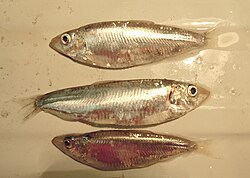| Black Sea sprat | |
|---|---|
 | |
| Scientific classification | |
| Kingdom: | Animalia |
| Phylum: | Chordata |
| Class: | Actinopterygii |
| Order: | Clupeiformes |
| Family: | Ehiravidae |
| Genus: | Clupeonella |
| Species: | C. cultriventris |
| Binomial name | |
| Clupeonella cultriventris | |
| Synonyms | |
| |

The Black Sea sprat or Pontic sprat, [1] Clupeonella cultriventris, is a small fish of the herring family, Clupeidae. It is found in the Black Sea and Sea of Azov and rivers of its basins: Danube, Dnister, Dnipro (Ukraine), Southern Bug, Don, Kuban. It has white-grey flesh and silver-grey scales. A typical size is 10 cm (3.9 in), maximum 15 cm (5.9 in). [4] The life span is up to 5 years. [4] The peak of its spawning is in April and it can be found in enormous shoals in sea-shores, filled all-round coastal shallows, moving quickly back into the sea at a depth of 6–30 metres (20–98 ft). Used for food; it has around 12% fat in flesh.
Contents
It is one of the most abundant fishes in the Sea of Azov. It is important prey for other fishes, particularly the pikeperch. [5]
The Caspian tyulka Clupeonella caspia has been long considered a subspecies of C. cultriventris, C. cultriventris caspia, and a common name "Black and Caspian Sea sprat" was then applied to the whole. [6] [4]

